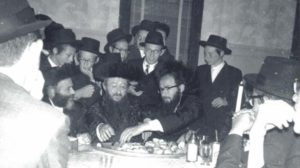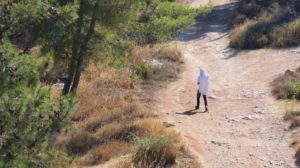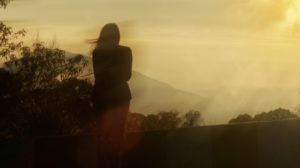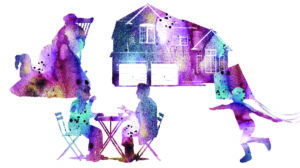A Time and a Place

I’d opened a portal connecting me to a treasure hidden for 77 years.

Mishpacha was on my nightstand all Shabbos, but I hadn’t had a chance to read it. When my husband went to Maariv, and all the kids were in bed, I opened the magazine, looking for something light, maybe a nice story to end Shabbos. This particular edition featured a story about the Lodz ghetto, which I figured would be too emotionally draining. But as I kept skimming through other articles, guilt hit me. My Saba a”h was from Lodz and had been forced into the ghetto with his family. I forced myself to read the article. Saba’s Holocaust experiences were too painful for him to relate, and I thought this article might give me some insight into his past.
One fact in particular hit like a ton of bricks. The article stated that the Lodz ghetto was unique in that it had a chevra kaddisha working until it was liquidated in 1944. If someone died in the ghetto from starvation prior to liquidation, they were zocheh to kever Yisrael. I recalled hearing that my father’s grandfather and uncle died of starvation in the ghetto, and was floored by this information.
I called my parents to wish them a gut voch. I was sure my father already knew about the Lodz ghetto’s chevra kaddisha, but he had no idea. I read him the article, which gave a website for more information about the Lodz cemetery. While we were on the phone, I looked up the site and entered the names of my father’s grandfather and uncle. I couldn’t believe it; there were matches. I’d opened a portal connecting me to a treasure hidden for 77 years. No one had known the yahrtzeits of my great-grandfather and great-uncle. But now I had the addresses of where they lived before the ghetto, in the ghetto, their plot burial location, and the dates of death.
Tears streamed from my eyes. Their yahrtzeits were familiar dates — the same dates as two of my brothers’ birthdays — and just one week away.
My father is the only child of my grandfather, and the sole survivor in his family. He’d never had any interest in setting foot in Poland, but now he felt an obligation to sanctify his grandfather’s and uncle’s memories by putting up matzeivos.
With the guidance of a family friend, Ari Scharf from Project Mesorah, we planned a family trip to erect matzeivos, and daven at their kevarim. Ari planned our trip, ordered the matzeivos, and introduced us to a genealogist who helped us map our family tree. We even found other gravesites of extended family members, and planned to visit them as well.
This past August, my parents and I flew to Poland. It was a very emotional trip. Of the millions who died with no proper burial, we felt some sense of solace that they at least would have a matzeivah, and we were able to daven at kivrei avos. There were 250,000 graves in the cemetery. Thousands of graves only had cold metal markers. We davened and cried.
How I wished Saba was alive to see this. He would have wanted to properly acknowledge his father and brother. It gave them an identity. They were no longer Section G, grave 564b, Side L and Section J, III Row, 7 grave 31, side L. They were restored to Yaakov Tzvi Sobol and Yisroel Sobol, a father and son from the great Ger chassidic dynasty who lived and died as true Torah Yidden.
After fulfilling our mission of putting up matzeivos and davening, we began looking for extended family members. My father’s great-uncle was also buried in the cemetery. We looked for his kever among the thousands for about half an hour. The cemetery is massive, and the day was physically and emotionally draining. My mother needed to sit down and drink water. She sat down next to one of the graves… and nearly fainted when she realized that out of 250,000 graves, she had chosen to sit next to my great-uncle’s.
Our guide was shaking. We were able to daven and cry by our great-uncle. We felt like Hashem led us on this amazing journey. We felt as if the meisim knew we were there and Hashem was guiding us to them. We were able to show Saba’s zeide and uncle that they were not abandoned or forgotten. We showed them that their legacy didn’t die in Poland, but lives on in their descendants, decades after them. We said the verse from Tehillim (118:17), “Lo amoos ki echyeh.”
After this trip, I gained a greater appreciation of who my bubbies and zeidies were, and how their lives, choices, and sacrifices paved the way for my own life. My zeide and uncle died al kiddush Hashem. Knowing their story obliges me to live my life in a way that honors their lives, to make sure their legacy lives on, and to make sure they didn’t die in vain but through their actions continue to inspire their descendants to be mikadeish Sheim Shamayim.
(Originally features in Mishpacha, Issue 744)
Oops! We could not locate your form.






